Conservation Biodiversity in Arid Areas: A Review
Abstract
:1. Introduction
2. Materials and Methods
3. Results
3.1. A Bibliometric Review
3.2. A Classical Review
3.2.1. Plants Related to Biodiversity Conservation in Arid Areas
3.2.2. Animals Related to Biodiversity Conservation in Arid Areas
3.2.3. Causes of Biodiversity Decline in Arid Regions
3.2.4. Effects of Biodiversity Loss in Arid Regions
3.2.5. Restoration Methods for Improving Biodiversity Conservation in Arid Areas
4. Discussion
4.1. Existing Literature on Biodiversity in Arid Areas
4.2. Restoration Strategies and Conservation Solutions
4.3. Limitations of the Study and Gaps in Existing Research
5. Conclusions
Author Contributions
Funding
Conflicts of Interest
References
- Vicente-Serrano, S.M.; Cabello, D.; Tomás-Burguera, M.; Martín-Hernández, N.; Beguería, S.; Azorin-Molina, C.; EI Kenawy, A. Drought Variability and Land Degradation in Semiarid Regions: Assessment Using Remote Sensing Data and Drought Indices (1982–2011). Remote Sens. 2015, 7, 4391–4423. [Google Scholar] [CrossRef]
- Wang, L.; D’Odorico, P.; Evans, J.P.; Eldridge, D.J.; McCabe, M.F.; Caylor, K.K.; King, E.G. Dryland Ecohydrology and Climate Change: Critical Issues and Technical Advances. Hydrol. Earth Syst. Sci. 2012, 16, 2585–2603. [Google Scholar] [CrossRef]
- Smith, W.K.; Dannenberg, M.P.; Yan, D.; Herrmann, S.; Barnes, M.L.; Barron-Gafford, G.A.; Biederman, J.A.; Ferrenberg, S.; Fox, A.M.; Hudson, A.; et al. Remote Sensing of Dryland Ecosystem Structure and Function: Progress, Challenges, and Opportunities. Remote Sens. Environ. 2019, 233, 111401. [Google Scholar] [CrossRef]
- Bradford, J.B.; Schlaepfer, D.R.; Lauenroth, W.K.; Palmquist, K.A.; Chambers, J.C.; Maestas, J.D.; Campbell, S.B. Climate-Driven Shifts in Soil Temperature and Moisture Regimes Suggest Opportunities to Enhance Assessments of Dryland Resilience and Resistance. Front. Ecol. Evol. 2019, 7, 358. [Google Scholar] [CrossRef]
- Singh, P.K.; Chudasama, H. Pathways for climate change adaptations in arid and semi-arid regions. J. Clean. Prod. 2021, 284, 124744. [Google Scholar] [CrossRef]
- Herrmann, S.M.; Brandt, M.; Rasmussen, K.; Fensholt, R. Accelerating Land Cover Change in West Africa over Four Decades as Population Pressure Increased. Commun. Earth Environ. 2020, 1, 53. [Google Scholar] [CrossRef]
- Sun, D. Detection of Dryland Degradation Using Landsat Spectral Unmixing Remote Sensing with Syndrome Concept in Minqin County, China. Int. J. Appl. Earth Obs. Geoinf. 2015, 41, 34–45. [Google Scholar] [CrossRef]
- Brandt, M.; Wigneron, J.P.; Chave, J.; Tagesson, T.; Penuelas, J.; Ciais, P.; Rasmussen, K.; Tian, F.; Mbow, C.; Al-Yaari, A.; et al. Satellite Passive Microwaves Reveal Recent Climate-Induced Carbon Losses in African Drylands. Nat. Ecol. Evol. 2018, 2, 827–835. [Google Scholar] [CrossRef] [PubMed]
- Fensholt, R.; Proud, S.R. Evaluation of Earth Observation Based Global Long Term Vegetation Trends—Comparing GIMMS and MODIS Global NDVI Time Series. Remote Sens. Environ. 2012, 119, 131–147. [Google Scholar] [CrossRef]
- Symeonakis, E.; Karathanasis, N.; Koukoulas, S.; Panagopoulos, G. Monitoring Sensitivity to Land Degradation and Desertification with the Environmentally Sensitive Area Index: The Case of Lesvos Island. Land Degrad. Dev. 2016, 27, 1562–1573. [Google Scholar] [CrossRef]
- Pimm, S.L. What is biodiversity conservation? This article belongs to Ambio’s 50th Anniversary Collection. Theme: Biodiversity Conservation. Ambio 2021, 50, 976–980. [Google Scholar] [CrossRef] [PubMed]
- Williams, L.J.; Cavender-Bares, J.; Townsend, P.A.; Couture, J.J.; Wang, Z.; Stefanski, A.; Reich, P.B. Remote spectral detection of biodiversity effects on forest biomass. Nat. Ecol. Evol. 2021, 5, 46–54. [Google Scholar] [CrossRef] [PubMed]
- Zhang, T.; Chen, Y.; Ali, S. Abiotic stress and human activities reduce plant diversity in desert riparian forests. Ecol. Indic. 2023, 152, 110340. [Google Scholar] [CrossRef]
- Bardgett, R.D.; Gibson, D.J. Plant ecological solutions to global food security. J. Ecol. 2017, 105, 859–864. [Google Scholar] [CrossRef]
- Borgman, C.L.; Rice, R.E. The Convergence of Information Science and Communication: A Bibliometric Analysis. J. Am. Soc. Inf. Sci. 1992, 43, 397–411. [Google Scholar] [CrossRef]
- Bornmann, L.; Mutz, R. Growth Rates of Modern Science: A Bibliometric Analysis Based on the Number of Publications and Cited References. J. Assoc. Inf. Sci. Technol. 2015, 66, 2215–2222. [Google Scholar] [CrossRef]
- Wallin, J.A. Bibliometric Methods: Pitfalls and Possibilities. Basic Clin. Pharmacol. Toxicol. 2005, 97, 261–275. [Google Scholar] [CrossRef]
- Aria, M.; Cuccurullo, C. Bibliometrix: An R-Tool for Comprehensive Science Mapping Analysis. J. Informetr. 2017, 11, 959–975. [Google Scholar] [CrossRef]
- Liu, X.; Zhang, L.; Hong, S. Global Biodiversity Research during 1900–2009: A Bibliometric Analysis. Biodivers. Conserv. 2011, 20, 807–826. [Google Scholar] [CrossRef]
- Michael Hall, C. Publish and Perish? Bibliometric Analysis, Journal Ranking and the Assessment of Research Quality in Tourism. Tour. Manag. 2011, 32, 16–27. [Google Scholar] [CrossRef]
- Michels, C.; Schmoch, U. The Growth of Science and Database Coverage. Scientometrics 2012, 93, 831–846. [Google Scholar] [CrossRef]
- Pautasso, M. Publication Growth in Biological Sub-Fields: Patterns, Predictability and Sustainability. Sustainability 2012, 4, 3234–3247. [Google Scholar] [CrossRef]
- Neff, M.W.; Corley, E.A. 35 Years and 160,000 Articles: A Bibliometric Exploration of the Evolution of Ecology. Scientometrics 2009, 80, 657–682. [Google Scholar] [CrossRef]
- Zhang, Y.; Chen, Y. Research Trends and Areas of Focus on the Chinese Loess Plateau: A Bibliometric Analysis during 1991–2018. Catena 2020, 194, 104798. [Google Scholar] [CrossRef]
- Shen, Z.Q.; Hu, N.; Xie, Z.H.; Gao, X.Y. Bibliometric analysis of the relationship between biodiversity and ecosystem functioning. Appl. Ecol. Environ. Res. 2024, 22, 569–586. [Google Scholar] [CrossRef]
- Yu, S.; Cui, B.; Xie, C.; Man, Y.; Fu, J. Bibliometric review of biodiversity offsetting during 1992–2019. Chin. Geogr. Sci. 2022, 32, 189–203. [Google Scholar] [CrossRef]
- Mabele, M.B.; Nnko, H.; Mwanyoka, I.; Kiwango, W.A.; Makupa, E. Inequalities in the production and dissemination of biodiversity conservation knowledge on Tanzania: A 50-year bibliometric analysis. Biol. Conserv. 2023, 279, 109910. [Google Scholar] [CrossRef]
- Shi, Y.F.; Huang, F.F.; Shi, S.H.; Jiang, Y.S.; Huang, X.M. Research Trends and Focus on the Deserts of Northern China: A Bibliometric Analysis During 1986–2020. Front. Earth Sci. 2021, 9, 777626. [Google Scholar] [CrossRef]
- Anzaldo-Montoya, M.; Hernández-García, Y.I.; Hernández-Montiel, L.G.; Hernández-Adame, L. Agronanotechnology in the arid zones of northern Mexico: Research, challenges, and new trends. J. Prof. Assoc. Cactus Dev. 2024, 26, 1–29. [Google Scholar] [CrossRef]
- Costa, D.P.; Herrmann, S.M.; Vasconcelos, R.N.; Duverger, S.G.; Franca Rocha, W.J.; Cambuí, E.C.; Lobão, J.S.; Santos, E.M.; Ferreira-Ferreira, J.; Oliveira, M.; et al. Bibliometric Analysis of Land Degradation Studies in Drylands Using Remote Sensing Data: A 40-Year Review. Land 2023, 12, 1721. [Google Scholar] [CrossRef]
- Web of Science Core Collection. 2024. Available online: https://clarivate.com/products/scientific-and-academic-research/research-discovery-and-workflow-solutions/webofscience-platform/web-of-science-core-collection/ (accessed on 21 August 2024).
- Microsoft Excel. 2024. Available online: https://www.microsoft.com/en-us/microsoft-365/excel?legRedir=true&CorrelationId=3bb60ab0-fe13-41a4-812b-2627667cf346 (accessed on 28 August 2024).
- Geochart. Available online: https://developers.google.com/chart/interactive/docs/gallery/geochart (accessed on 23 August 2024).
- VOS Viewer. Available online: https://www.vosviewer.com/ (accessed on 23 August 2024).
- David, K.; Amy, G.; Derek, B. Evaluation of restoration success to inform future restoration efforts in Acacia reficiens invaded rangelands in northern Kenya. Ecol. Restor. 2020, 38, 105–113. [Google Scholar] [CrossRef]
- Klimova, A.; Gutíerrez-Rivera, J.; Ortega-Rubio, A.; Eguiarte, L.E. Population genomics and distribution modeling revealed the history and suggested a possible future of the endemic Agave aurea (Asparagaceae) complex in the Baja California Peninsula. Ecol. Evol. 2024, 14, e70027. [Google Scholar] [CrossRef] [PubMed]
- Tariq, A.; Ullah, A.; Sardans, J.; Zeng, F.; Graciano, C.; Li, X.; Wang, W.; Ahmed, Z.; Ali, S.; Zhang, Z.; et al. Alhagi sparsifolia: An ideal phreatophyte for combating desertification and land degradation. Sci. Total Environ. 2022, 844, 157228. [Google Scholar] [CrossRef]
- Sabo, P.; Ouédraogo, A.; Lankoandé, B.; Salako, K.V.; Ouédraogo, H.; Kakaï, R.G. Influence of topography on the natural stand structure of Boswellia dalzielii Hutch. in a semi-arid environment: Insight into hill ecosystems conservation in Burkina Faso. Glob. Ecol. Conserv. 2023, 43, e02430. [Google Scholar] [CrossRef]
- La Montagna, D.; Attorre, F.; Hamdiah, S.; Maděra, P.; Malatesta, L.; Vahalík, P.; Van Damme, K.; De Sanctis, M. Climate change effects on the potential distribution of the endemic Commiphora species (Burseraceae) on the island of Socotra. Front. For. Glob. Change 2023, 6, 1183858. [Google Scholar] [CrossRef]
- Kulloli, R.N.; Purohit, C.S.; Kumar, S.; Jindal, S.K.; Rawat, K.; Acharya, D. Distribution of Commiphora wightii (Arnt.) Bhand. in Rajasthan with Special Emphasis on its Conservation Planning in Arid Areas. Vegetos 2013, 26, 113–120. [Google Scholar] [CrossRef]
- Akpalu, S.E.; Anglaaere, L.; Damnyag, L.; Dawoe, E.K.; Abunyewa, A.A.; Akpalu, M.M. Floristic composition of agroforestry parklands in the semi-arid zone of Ghana: A special focus on Faidherbia albida (Delile) A. Chev. Trees For. People 2022, 9, 100310. [Google Scholar] [CrossRef]
- Zhang, J.T.; Xu, B.; Li, M. Genetic diversity of populations of an endangered medicinal plant species (Glycyrrhiza uralensis) in different environments of North China. J. Med. Plants Res. 2010, 4, 830–836. [Google Scholar]
- Visioni, A.; Basile, B.; Amri, A.; Sanchez-Garcia, M.; Corrado, G. Advancing the conservation and utilization of barley genetic resources: Insights into germplasm management and breeding for sustainable agriculture. Plants 2023, 12, 3186. [Google Scholar] [CrossRef]
- Penas, J.; Benito, B.; Lorite, J.; Ballesteros, M.; Cañadas, E.M.; Martinez-Ortega, M. Habitat fragmentation in arid zones: A case study of Linaria nigricans under land use changes (SE Spain). Environ. Manag. 2011, 48, 168–176. [Google Scholar] [CrossRef]
- Muthoka, J.M.; Salakpi, E.E.; Ouko, E.; Yi, Z.F.; Antonarakis, A.S.; Rowhani, P. Mapping Opuntia stricta in the arid and semi-arid environment of kenya using sentinel-2 imagery and ensemble machine learning classifiers. Remote Sens. 2021, 13, 1494. [Google Scholar] [CrossRef]
- Kinhal, V.; Parthasarathy, N. Nucleated succession by an endemic palm Phoenix pusilla enhances diversity of woody species in the arid Coromandel Coast of India. AoB Plants 2010, 2010, plq007. [Google Scholar] [CrossRef] [PubMed]
- Hailemariam, M.B.; Woldu, Z.; Asfaw, Z.; Lulekal, E. Ethnobotany of an indigenous tree Piliostigma thonningii (Schumach.) Milne-Redh. (Fabaceae) in the arid and semi-arid areas of South Omo Zone, southern Ethiopia. J. Ethnobiol. Ethnomed. 2021, 17, 44. [Google Scholar] [CrossRef] [PubMed]
- Abdelaal, M.; Fois, M.; Dakhil, M.A.; Bacchetta, G.; El-Sherbeny, G.A. Predicting the potential current and future distribution of the endangered endemic vascular plant Primula boveana Decne. ex Duby in Egypt. Plants 2020, 9, 957. [Google Scholar] [CrossRef] [PubMed]
- Kalarikkal, R.K.; Kim, Y.; Ksiksi, T. Incorporating satellite remote sensing for improving potential habitat simulation of Prosopis cineraria (L.) Druce in United Arab Emirates. Glob. Ecol. Conserv. 2022, 37, e02167. [Google Scholar] [CrossRef]
- Baibout, M.; Corcket, E.; Kothari, S.L.; Fievet, V. Ecosystem services provided by Prosopis cineraria (L.) Druce in the drylands of Southern and Western Asia. Bot. Lett. 2022, 169, 30–42. [Google Scholar] [CrossRef]
- Amiri, M.; Tarkesh, M.; Shafiezadeh, M. Modelling the biological invasion of Prosopis juliflora using geostatistical-based bioclimatic variables under climate change in arid zones of southwestern Iran. J. Arid. Land 2022, 14, 203–224. [Google Scholar] [CrossRef]
- Sadeghi, M.; Malekian, M.; Esfahani, M.T. Interspecific niche overlap and climatic associations of native Quercus species in the Zagros forests of Iran. Glob. Ecol. Conserv. 2024, 51, e02878. [Google Scholar] [CrossRef]
- Omar, K.; Elgamal, I. Conservation of challenging endemic plant species at high risk of extinction in arid mountain ecosystems: A case study of Rosa arabica Crép. in Egypt. J. Mt. Sci. 2021, 18, 2698–2721. [Google Scholar] [CrossRef]
- Martinez, F.J.; Dellape, P.M.; Bisigato, A.J.; Cheli, G.H. Native shrubs and their importance for arthropod diversity in the southern Monte, Patagonia, Argentina. J. Insect Conserv. 2021, 25, 27–38. [Google Scholar] [CrossRef]
- Ben Mariem, H.; Chaieb, M. Climate change impacts on the distribution of Stipa tenacissima L. ecosystems in North African arid zone-a case study in Tunisia. Appl. Ecol. Environ. Res. 2017, 15, 67–82. [Google Scholar] [CrossRef]
- Natale, E.; Zalba, S.M.; Oggero, A.; Reinoso, H. Establishment of Tamarix ramosissima under different conditions of salinity and water availability: Implications for its management as an invasive species. J. Arid. Environ. 2010, 74, 1399–1407. [Google Scholar] [CrossRef]
- Nkosi, S. Predicting habitat suitability for Vachellia (Acacia) tortilis (Forskk.) and Vachellia stuhlmannii (Taub.) in semi-arid African savanna using Maxent. Appl. Ecol. Environ. Res. 2024, 22, 4463–4480. [Google Scholar] [CrossRef]
- Li, F.R.; Liu, J.L.; Liu, C.A.; Liu, Q.J.; Niu, R.X. Shrubs and species identity effects on the distribution and diversity of ground-dwelling arthropods in a Gobi desert. J. Insect Conserv. 2013, 17, 319–331. [Google Scholar] [CrossRef]
- Cruz, T.M.P.; Buchmann, S.L.; Prudic, K.L. Buzzing towards Resilience: Investigating the Spatial Alignment of the Desert Pallid Bee, Centris pallida, and Its Host Plants in Response to Climate Change. Insects 2024, 15, 793. [Google Scholar] [CrossRef]
- Cheli, G.H.; Flores, G.E.; Román, N.M.; Podestá, D.; Mazzanti, R.; Miyashiro, L. A Tenebrionid beetle’s dataset (Coleoptera, Tenebrionidae) from Peninsula Valdés (Chubut, Argentina). ZooKeys 2013, 364, 93. [Google Scholar] [CrossRef]
- Li, Y.; Wang, Y.; Zhang, H.; Lou, C.; Ren, G. Energy Availability Factors Drive the Geographical Pattern of Tenebrionidae (Coleoptera) in the Arid and Semiarid Areas of China. Diversity 2022, 15, 18. [Google Scholar] [CrossRef]
- Cheli, G.H.; Carrara, R.; Bandieri, L.; Flores, G.E. Distribution and environmental determinants of darkling beetles assemblages (Coleoptera: Tenebrionidae) in Península Valdés (Argentinean Patagonia). An. Acad. Bras. Ciências 2021, 93, e20201282. [Google Scholar] [CrossRef]
- Herrera-Russert, J.; López-López, A.; Serrano, J.; Cordero-Rivera, A.; Galián, J. First population estimates of the vulnerable southeast Iberian endemic tiger beetle Cephalota (Taenidia) deserticoloides. Insect Conserv. Divers. 2021, 14, 793–799. [Google Scholar] [CrossRef]
- Marteis, L.S.; Sallum, M.A.M.; Natal, D.; Oliveira, T.M.P.; Gama, R.A.; Dolabella, S.S.; Santos, R.L.C.D. First record of Anopheles oryzalimnetes, Anopheles argyritarsis, and Anopheles sawyeri (Diptera: Culicidae) in the Caatinga Biome, semiarid scrubland of Sergipe State, Brazil. J. Med. Entomol. 2015, 52, 858–865. [Google Scholar] [CrossRef]
- Rix, M.G.; Huey, J.A.; Main, B.Y.; Waldock, J.M.; Harrison, S.E.; Comer, S.; Austin, A.D.; Harvey, M.S. Where have all the spiders gone? The decline of a poorly known invertebrate fauna in the agricultural and arid zones of southern Australia. Austral Entomol. 2017, 56, 14–22. [Google Scholar] [CrossRef]
- Smith DiCarlo, L.A.; DeBano, S.J. Spider community variability and response to restoration in arid grasslands of the pacific northwest, USA. Insects 2021, 12, 249. [Google Scholar] [CrossRef]
- Lira, A.F.; Foerster, S.Í.; Badry, A. Living in a desert: Examining scorpion beta diversity in Egyptian drylands from a macroecological perspective. Afr. Zool. 2023, 58, 18–28. [Google Scholar] [CrossRef]
- Bestelmeyer, B.T.; Schooley, R.L. The ants of the southern Sonoran Desert: Community structure and the role of trees. Biodivers. Conserv. 1999, 8, 643–657. [Google Scholar] [CrossRef]
- Begum, R.; Majagi, S.H.; Vijaykumar, K. Ants species richness and diversity in relation to different ecological habitat in selected localities of the semi-arid region of Karnataka, India. Environ. Monit. Assess. 2021, 193, 145. [Google Scholar] [CrossRef]
- Pizarro-Araya, J.; Alfaro, F.M.; Corta, M.; Rivera, C.; Vargas-Talciani, P.; Ojanguren-Affilastro, A.A. Epigean Insects of Chaparal Island (Pingüino de Humboldt National Reserve, Atacama, Chile). J. Entomol. Res. Soc. 2014, 16, 39–50. [Google Scholar]
- Schapheer, C.; Lopez-Uribe, M.M.; Vera, A.; Villagra, C.A. Distribution, habitat use and plant associations of Moluchia brevipennis (Saussure, 1864) (Blattodea: Ectobiidae): An endemic cockroach from Chilean Mediterranean Matorral biome. Rev. Bras. Entomol. 2017, 61, 114–122. [Google Scholar] [CrossRef]
- Rowe, H.I.; Johnson, B.; Broatch, J.; Cruz, T.M.P.; Prudic, K.L. Winter Rains Support Butterfly Diversity, but Summer Monsoon Rainfall Drives Post-Monsoon Butterfly Abundance in the Arid Southwest of the US. Insects 2023, 15, 5. [Google Scholar] [CrossRef]
- Wang, Y.; Chen, J.; Liu, W.; Xu, R. Effect of cultivating croplands and grazing in arid grassland habitats on the conservation of melitaeine butterflies in a mountainous area in Northern China. Sci. China Ser. C Life Sci. 2007, 50, 40–46. [Google Scholar] [CrossRef]
- Balderas, S.; Lozano-Vilano, L. Water, endangered fishes, and development perspectives in arid lands of Mexico. Conserv. Biol. 1994, 8, 379–387. [Google Scholar] [CrossRef]
- Esmaeili, H.R.; Eslami Barzoki, Z. Climate Change May Impact Nile Tilapia, Oreochromis niloticus (Linnaeus, 1758) Distribution in the Southeastern Arabian Peninsula through Range Contraction under Various Climate Scenarios. Fishes 2023, 8, 481. [Google Scholar] [CrossRef]
- Sampaio, M.; Velo-Antón, G.; Martínez-Freiría, F.; Sánchez-Vialas, A.; Pleguezuelos, J.M.; Geniez, P.; Brito, J.C. Beyond the comfort zone: Amphibian diversity and distribution in the West Sahara-Sahel using mtDNA and nuDNA barcoding and spatial modelling. Conserv. Genet. 2021, 22, 233–248. [Google Scholar] [CrossRef]
- Roth-Monzón, A.J.; Mendoza-Hernández, A.A.; Flores-Villela, O. Amphibian and reptile biodiversity in the semi-arid region of the municipality of Nopala de Villagrán, Hidalgo, Mexico. PeerJ 2018, 6, e4202. [Google Scholar] [CrossRef] [PubMed]
- Elbahi, A.; Lawton, C.; Oubrou, W.; El Bekkay, M.; Hermas, J.; Dugon, M. Assessment of reptile response to habitat degradation in arid and semi-arid regions. Glob. Ecol. Conserv. 2023, 45, e02536. [Google Scholar] [CrossRef]
- Carranza, S.; Xipell, M.; Tarroso, P.; Gardner, A.; Arnold, E.N.; Robinson, M.D.; Simó-Riudalbas, M.; Vasconcelos, R.; de Pous, P.; Amat, F.; et al. Diversity, distribution and conservation of the terrestrial reptiles of Oman (Sauropsida, Squamata). PLoS ONE 2018, 13, e0190389. [Google Scholar] [CrossRef] [PubMed]
- Duckett, P.E.; Wilson, P.D.; Stow, A.J. Keeping up with the neighbours: Using a genetic measurement of dispersal and species distribution modelling to assess the impact of climate change on an A ustralian arid zone gecko (G ehyra variegata). Divers. Distrib. 2013, 19, 964–976. [Google Scholar] [CrossRef]
- Garcia-Porta, J.; Simó-Riudalbas, M.; Robinson, M.; Carranza, S. Diversification in arid mountains: Biogeography and cryptic diversity of Pristurus rupestris rupestris in Arabia. J. Biogeogr. 2017, 44, 1694–1704. [Google Scholar] [CrossRef]
- Rossini, R.A.; Fensham, R.J.; Walter, G.H. Spatiotemporal variance of environmental conditions in Australian artesian springs affects the distribution and abundance of six endemic snail species. Aquat. Ecol. 2017, 51, 511–529. [Google Scholar] [CrossRef]
- Lagarde, F.; Louzizi, T.; Slimani, T.; El Mouden, H.; Kaddour, K.B.; Moulherat, S.; Bonnet, X. Bushes protect tortoises from lethal overheating in arid areas of Morocco. Environ. Conserv. 2012, 39, 172–182. [Google Scholar] [CrossRef]
- Flesch, A.D.; Nabhan, G.P.; Holm, P. Historical changes in bird communities at Quitobaquito Springs, Arizona and impacts of climate, spring flow, and shift from Indigenous to federal-agency management. J. Arid. Environ. 2023, 219, 105075. [Google Scholar] [CrossRef]
- Githaiga-Mwicigi, J.M.; Fairbanks, D.H.; Midgley, G. Hierarchical processes define spatial pattern of avian assemblages restricted and endemic to the arid Karoo, South Africa. J. Biogeogr. 2002, 29, 1067–1087. [Google Scholar] [CrossRef]
- Alves, R.R.N.; Leite, R.C.L.; Souto, W.M.S.; Bezerra, D.M.; Loures-Ribeiro, A. Ethno-ornithology and conservation of wild birds in the semi-arid Caatinga of northeastern Brazil. J. Ethnobiol. Ethnomedicine 2013, 9, 14. [Google Scholar] [CrossRef] [PubMed]
- Martínez, J.A.; Zuberogoitia, I.; Martínez, J.E.; Zabala, J.; Calvo, J.F. Patterns of territory settlement by Eurasian scops-owls (Otus scops) in altered semi-arid landscapes. J. Arid. Environ. 2007, 69, 400–409. [Google Scholar] [CrossRef]
- Crego, R.D.; Hernández-Yáñez, H.; Rabeil, T.; Hingrat, Y.; Leimgruber, P.; Stabach, J.A. Non-systematic surveys reveal increases in areas occupied by endangered and data-deficient Nubian bustard. Glob. Ecol. Conserv. 2023, 47, e02682. [Google Scholar] [CrossRef]
- Berger, J.; Buuveibaatar, B.; Mishra, C. Globalization of the cashmere market and the decline of large mammals in Central Asia. Conserv. Biol. 2013, 27, 679–689. [Google Scholar] [CrossRef] [PubMed]
- Pedler, R.D.; Brandle, R.; Read, J.L.; Southgate, R.; Bird, P.; Moseby, K.E. Rabbit biocontrol and landscape-scale recovery of threatened desert mammals. Conserv. Biol. 2016, 30, 774–782. [Google Scholar] [CrossRef] [PubMed]
- Urquizo, J.H.; Barquez, R.M.; Ferro, I. The elevation gradient of small mammals richness and abundance in the dry Andes of northwestern Argentina. J. Arid. Environ. 2022, 204, 104792. [Google Scholar] [CrossRef]
- Lison, F.; Jiménez-Franco, M.V.; Altamirano, A.; Haz, A.; Calvo, J.F.; Jones, G. Bat ecology and conservation in semi-arid and arid landscapes: A global systematic review. Mammal Rev. 2020, 50, 52–67. [Google Scholar] [CrossRef]
- Kahnonitch, I.; Lubin, Y.; Korine, C. Insectivorous bats in semi-arid agroecosystems− effects on foraging activity and implications for insect pest control. Agric. Ecosyst. Environ. 2018, 261, 80–92. [Google Scholar] [CrossRef]
- Acosta, R.; Fernández, J.A. Flea diversity and prevalence on arid-adapted rodents in the Oriental Basin, Mexico. Rev. Mex. Biodivers. 2015, 86, 981–988. [Google Scholar] [CrossRef]
- O’Neill, S.; Short, J.; Calver, M. The distribution, habitat preference and population dynamics of the pale field-rat (Rattus tunneyi) at Edel Land, Shark Bay, Western Australia: The role of refuges and refugia in population persistence. Wildl. Res. 2021, 48, 444–457. [Google Scholar] [CrossRef]
- Evans, S.W. The effects of habitat loss and fragmentation on the relative abundance and conservation of Ludwig’s Bustard Neotis ludwigii in South Africa. Ostrich 2023, 94, 186–203. [Google Scholar] [CrossRef]
- McAlpine, C.A.; Grigg, G.C.; Mott, J.J.; Sharma, P. Influence of landscape structure on kangaroo abundance in a disturbed semi-arid woodland of Queensland. Rangel. J. 1999, 21, 104–134. [Google Scholar] [CrossRef]
- Dunlop, J.A.; Rayner, K.; Doherty, T.S. Dietary flexibility in small carnivores: A case study on the endangered northern quoll, Dasyurus hallucatus. J. Mammal. 2017, 98, 858–866. [Google Scholar] [CrossRef]
- Sheldon, E.L.; Feit, B.; Feit, A.; Letnic, M. Negative frequency dependent prey selection by two canid predators and its implications for the conservation of a threatened rodent in arid Australia. Biodivers. Conserv. 2023, 32, 1671–1686. [Google Scholar] [CrossRef]
- Karssene, Y.; Chammem, M.; Khorchani, T.; Nouira, S.; Li, F. Global warming drives changes in carnivore communities in the North Sahara Desert. Clim. Res. 2017, 72, 153–162. [Google Scholar] [CrossRef]
- Tatler, J.; Prowse, T.A.; Roshier, D.A.; Allen, B.L.; Cassey, P. Resource pulses affect prey selection and reduce dietary diversity of dingoes in arid Australia. Mammal Rev. 2019, 49, 263–275. [Google Scholar] [CrossRef]
- Zapararte, M.B.; Napolitano, C.; Sapaj-Aguilera, M.; Dinges, T.; Kenrick, C.; Llerena-Reátegui, G.; Tellaeche, C.G.; Palacios, R. New Records of the Andean Cat (Leopardus jacobita) in the Central Andes of Chile: Filling Gaps in the Distribution Range through Private-Social Partnerships. Animals 2022, 12, 639. [Google Scholar] [CrossRef]
- Meng, N.; Wang, N.A.; Cheng, H.; Liu, X.; Niu, Z. Impacts of climate change and anthropogenic activities on the normalized difference vegetation index of desertified areas in northern China. J. Geogr. Sci. 2023, 33, 483–507. [Google Scholar] [CrossRef]
- Chen, Y.; Li, W.; Xu, C.; Ye, Z.; Chen, Y. Desert riparian vegetation and groundwater in the lower reaches of the Tarim River basin. Environ. Earth Sci. 2015, 73, 547–558. [Google Scholar] [CrossRef]
- Hou, L.F.; Sun, G.Q.; Perc, M. The impact of heterogeneous human activity on vegetation patterns in arid environments. Commun. Nonlinear Sci. Numer. Simul. 2023, 126, 107461. [Google Scholar] [CrossRef]
- Liu, X.; Chen, X.; Hua, K.; Wang, Y.; Wang, P.; Han, X.; Wen, S. Effects of land use change on ecosystem services in arid area ecological migration. Chin. Geogr. Sci. 2018, 28, 894–906. [Google Scholar] [CrossRef]
- Mugari, E.; Masundire, H. Consistent changes in land-use/land-cover in semi-arid areas: Implications on ecosystem service delivery and adaptation in the limpopo basin, Botswana. Land 2022, 11, 2057. [Google Scholar] [CrossRef]
- Appelgren, B. Towards Sustainable Dryland Development in Africa: Integrating Groundwater and Land Management. In Proceedings of the Future of Drylands: International Scientific Conference on Desertification and Drylands Research, Tunis, Tunisia, 19–21 June 2006; Springer: Heidelberg, The Netherlands, 2008; pp. 199–208. [Google Scholar] [CrossRef]
- Korell, L.; Auge, H.; Chase, J.M.; Harpole, W.S.; Knight, T.M. Responses of plant diversity to precipitation change are strongest at local spatial scales and in drylands. Nat. Commun. 2021, 12, 2489. [Google Scholar] [CrossRef] [PubMed]
- Hussein, E.A.; Abd El-Ghani, M.M.; Hamdy, R.S.; Shalabi, L.F. Do anthropogenic activities affect floristic diversity and vegetation structure more than natural soil properties in hyper-arid desert environments? Diversity 2021, 13, 157. [Google Scholar] [CrossRef]
- Teklehaymanot, T. An ethnobotanical survey of medicinal and edible plants of Yalo Woreda in Afar regional state, Ethiopia. J. Ethnobiol. Ethnomedicine 2017, 13, 40. [Google Scholar] [CrossRef] [PubMed]
- Espinosa, M.I.; Gouin, N.; Squeo, F.A.; López, D.; Bertin, A. Landscape connectivity among remnant populations of guanaco (Lama guanicoe Müller, 1776) in an arid region of Chile impacted by global change. PeerJ 2018, 6, e4429. [Google Scholar] [CrossRef]
- Khan, M.; Mahmood, H.Z.; Abbas, G.; Damalas, C.A. Agroforestry systems as alternative land-use options in the arid zone of Thal, Pakistan. Small-Scale For. 2017, 16, 553–569. [Google Scholar] [CrossRef]
- Moreno-Calles, A.I.; Casas, A.; García-Frapolli, E.; Torres-García, I. Traditional agroforestry systems of multi-crop “milpa” and “chichipera” cactus forest in the arid Tehuacán Valley, Mexico: Their management and role in people’s subsistence. Agrofor. Syst. 2012, 84, 207–226. [Google Scholar] [CrossRef]
- Brunori, E.; Maesano, M.; Moresi, F.V.; Matteucci, G.; Biasi, R.; Scarascia Mugnozza, G. The hidden land conservation benefits of olive-based (Olea europaea L.) landscapes: An agroforestry investigation in the southern Mediterranean (Calabria region, Italy). Land Degrad. Dev. 2020, 31, 801–815. [Google Scholar] [CrossRef]
- Rohatyn, S.; Rotenberg, E.; Yakir, D.; Carmel, Y. Assessing climatic benefits from forestation potential in semi-arid lands. Environ. Res. Lett. 2021, 16, 104039. [Google Scholar] [CrossRef]
- Karamian, M.; Mirzaei, J.; Heydari, M.; Mirab-Balou, M.; Kooch, Y.; Pehlivan, N. Non-native and native tree species plantations and seasonality could have substantial impacts on the diversity of indigenous soil fauna in a semi-arid forest ecosystem. Environ. Monit. Assess. 2023, 195, 1268. [Google Scholar] [CrossRef]
- Bessega, C.; Cony, M.; Saidman, B.O.; Aguiló, R.; Villagra, P.; Alvarez, J.A.; Pometti, C.; Vilardi, J.C. Genetic diversity and differentiation among provenances of Prosopis flexuosa DC (Leguminosae) in a progeny trial: Implications for arid land restoration. For. Ecol. Manag. 2019, 443, 59–68. [Google Scholar] [CrossRef]
- McDonald, S.E.; Reid, N.; Smith, R.; Waters, C.M.; Hunter, J.; Rader, R. Rotational grazing management achieves similar plant diversity outcomes to areas managed for conservation in a semi-arid rangeland. Rangel. J. 2019, 41, 135–145. [Google Scholar] [CrossRef]
- Fensham, R.J.; Silcock, J.L.; Firn, J. Managed livestock grazing is compatible with the maintenance of plant diversity in semidesert grasslands. Ecol. Appl. 2014, 24, 503–517. [Google Scholar] [CrossRef] [PubMed]
- Haarmeyer, D.H.; Schmiedel, U.; Dengler, J.; Bösing, B.M. How does grazing intensity affect different vegetation types in arid Succulent Karoo, South Africa? Implications for conservation management. Biol. Conserv. 2010, 143, 588–596. [Google Scholar] [CrossRef]
- Neilly, H.; O’Reagain, P.; Vanderwal, J.; Schwarzkopf, L. Profitable and sustainable cattle grazing strategies support reptiles in tropical savanna rangeland. Rangel. Ecol. Manag. 2018, 71, 205–212. [Google Scholar] [CrossRef]
- Bowker, M.A.; Miller, M.E.; Belnap, J.; Sisk, T.D.; Johnson, N.C. Prioritizing conservation effort through the use of biological soil crusts as ecosystem function indicators in an arid region. Conserv. Biol. 2008, 22, 1533–1543. [Google Scholar] [CrossRef]
- Canton Castilla, Y.; Roncero-Ramos, B.; Román Fernández, R.; Rodríguez Caballero, E.; de la Piedra, S.C. Biocrust restoration: A key tool to recover degraded arid ecosystem functioning. Ecosistemas 2021, 30, 2236. [Google Scholar] [CrossRef]
- Gürsu, H. An Affordable System Solution for Enhancing Tree Survival in Dry Environments. Sustainability 2024, 16, 5994. [Google Scholar] [CrossRef]
- Wu, P.; Qin, B.; Zhang, Z.; Zhao, Y.; Hu, Y.; Chen, Y. Effects of drainage water on plant diversity and distribution of agricultural drainage ditch beds in an arid irrigated area of Northwestern China. Chem. Ecol. 2015, 31, 679–691. [Google Scholar] [CrossRef]
- Meena, H. Climate Change: Biodiversity Conservation with Reference to Thar Desert. In Proceedings of the International Conference on Climate Change, Colombo, Sri Lanka, 16–17 February 2017; Volume 1, pp. 1–6. [Google Scholar] [CrossRef]
- Chiu, W.T.; Ho, Y. Bibliometric analysis of tsunami research. Scientometrics 2007, 73, 3–17. [Google Scholar] [CrossRef]
- Durisin, B.; Calabretta, G.; Parmeggiani, V. The intellectual structure of product innovation research: A bibliometric study of the journal of product innovation management, 1984–2004. J. Prod. Innov. Manag. 2010, 27, 437–451. [Google Scholar] [CrossRef]
- Borrett, S.R.; Sheble, L.; Moody, J.; Anway, E.C. Bibliometric review of ecological network analysis: 2010–2016. Ecol. Model. 2018, 382, 63–82. [Google Scholar] [CrossRef]
- Dinca, L.; Crisan, V.; Ienasoiu, G.; Murariu, G.; Drasovean, R. Environmental Indicator Plants in Mountain Forests: A Review. Plants 2024, 13, 3358. [Google Scholar] [CrossRef] [PubMed]
- U.S. Geological Survey. Dryland Ecosystems. U.S. Geological Survey. Available online: https://www.usgs.gov/special-topics/drought/science/dryland-ecosystems (accessed on 5 December 2024).
- Li, C.; Fu, B.; Wang, S.; Stringer, L.C.; Wang, Y.; Li, Z.; Liu, Y.; Zhou, W. Drivers and impacts of changes in China’s drylands. Nat. Rev. Earth Environ. 2021, 2, 858–873. [Google Scholar] [CrossRef]
- Maltseva, D.; Batagelj, V. Towards a systematic description of the field using keywords analysis: Main topics in social networks. Scientometrics 2020, 123, 357–382. [Google Scholar] [CrossRef]
- González, L.M.; García-Massó, X.; Pardo-Ibañez, A.; Peset, F.; Devís-Devís, J. An author keyword analysis for mapping Sport Sciences. PLoS ONE 2018, 13, e0201435. [Google Scholar] [CrossRef]
- Raamkumar, A.S.; Foo, S.; Pang, N. Using author-specified keywords in building an initial reading list of research papers in scientific paper retrieval and recommender systems. Inf. Process. Manag. 2017, 53, 577–594. [Google Scholar] [CrossRef]
- Chen, P.I.; Lin, S.J. Automatic keyword prediction using Google similarity distance. Expert Syst. Appl. 2010, 37, 1928–1938. [Google Scholar] [CrossRef]
- Choi, J.; Yi, S.; Lee, K.C. Analysis of keyword networks in MIS research and implications for predicting knowledge evolution. Inf. Manag. 2011, 48, 371–381. [Google Scholar] [CrossRef]
- Davies, J. Biodiversity and the Great Green Wall; IUCN: Ouagadougou, Burkina Faso, 2017; Available online: https://iucn.org/resources/publication/biodiversity-and-great-green-wall (accessed on 12 January 2025).
- Bond, W.J.; Stevens, N.; Midgley, G.F.; Lehmann, C.E. The trouble with trees: Afforestation plans for Africa. Trends Ecol. Evol. 2019, 34, 963–965. [Google Scholar] [CrossRef] [PubMed]
- Ullah, A.; Munir, S.; Badshah, S.L.; Khan, N.; Ghani, L.; Poulson, B.G.; Emwas, A.H.; Jaremko, M. Important flavonoids and their role as a therapeutic agent. Molecules 2020, 25, 5243. [Google Scholar] [CrossRef] [PubMed]
- Naia, M.; Hermoso, V.; Carvalho, S.B.; Brito, J.C. Promoting connectivity between priority freshwater sites for conservation in intermittent hydrological systems. Aquat. Conserv. Mar. Freshw. Ecosyst. 2021, 31, 1886–1900. [Google Scholar] [CrossRef]
- Zhang, Y.; Tariq, A.; Hughes, A.C.; Hong, D.; Wei, F.; Sun, H.; Sardans, J.; Peñuelas, J.; Perry, G.; Qiao, J.; et al. Challenges and solutions to biodiversity conservation in arid lands. Sci. Total Environ. 2023, 857, 159695. [Google Scholar] [CrossRef]
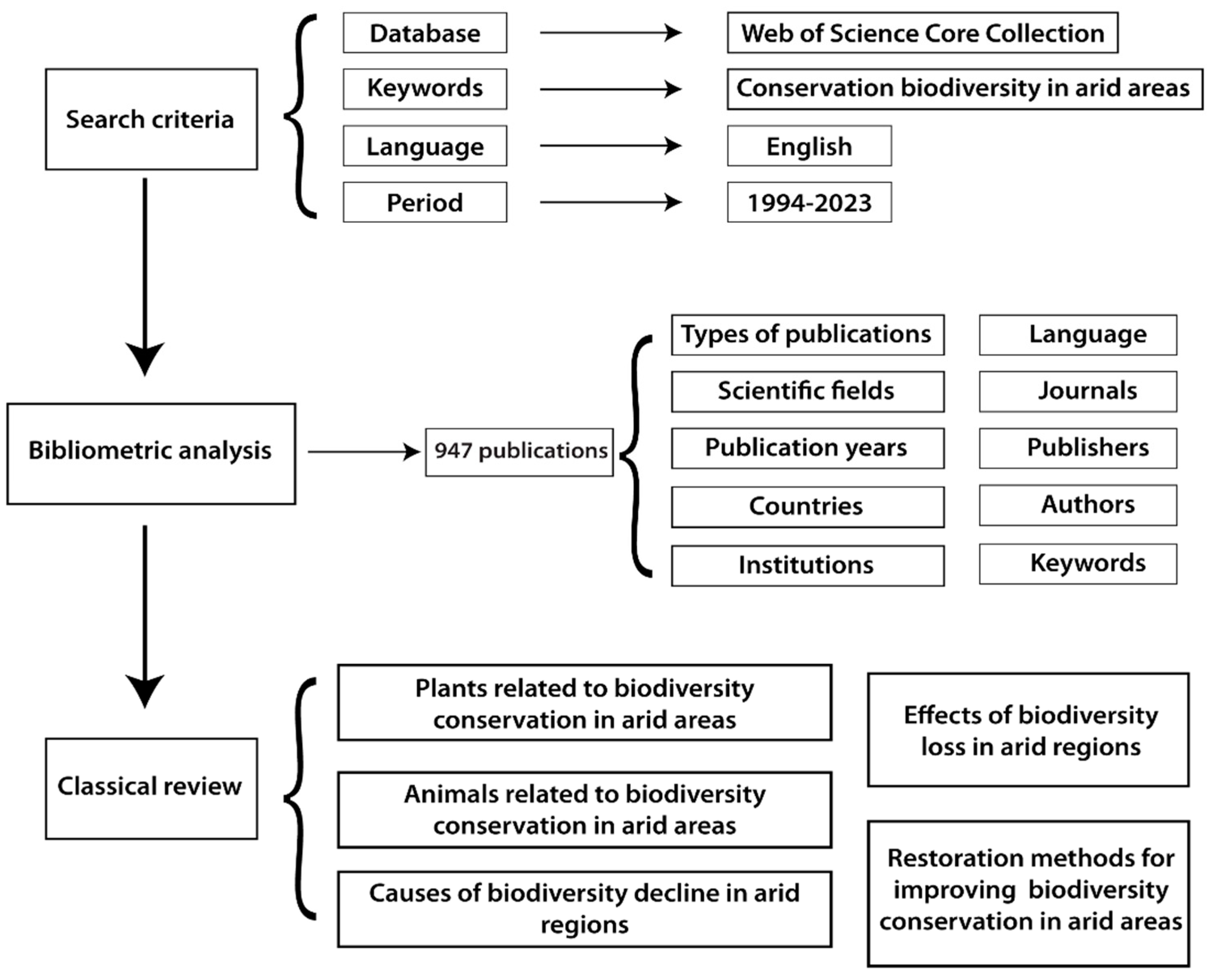
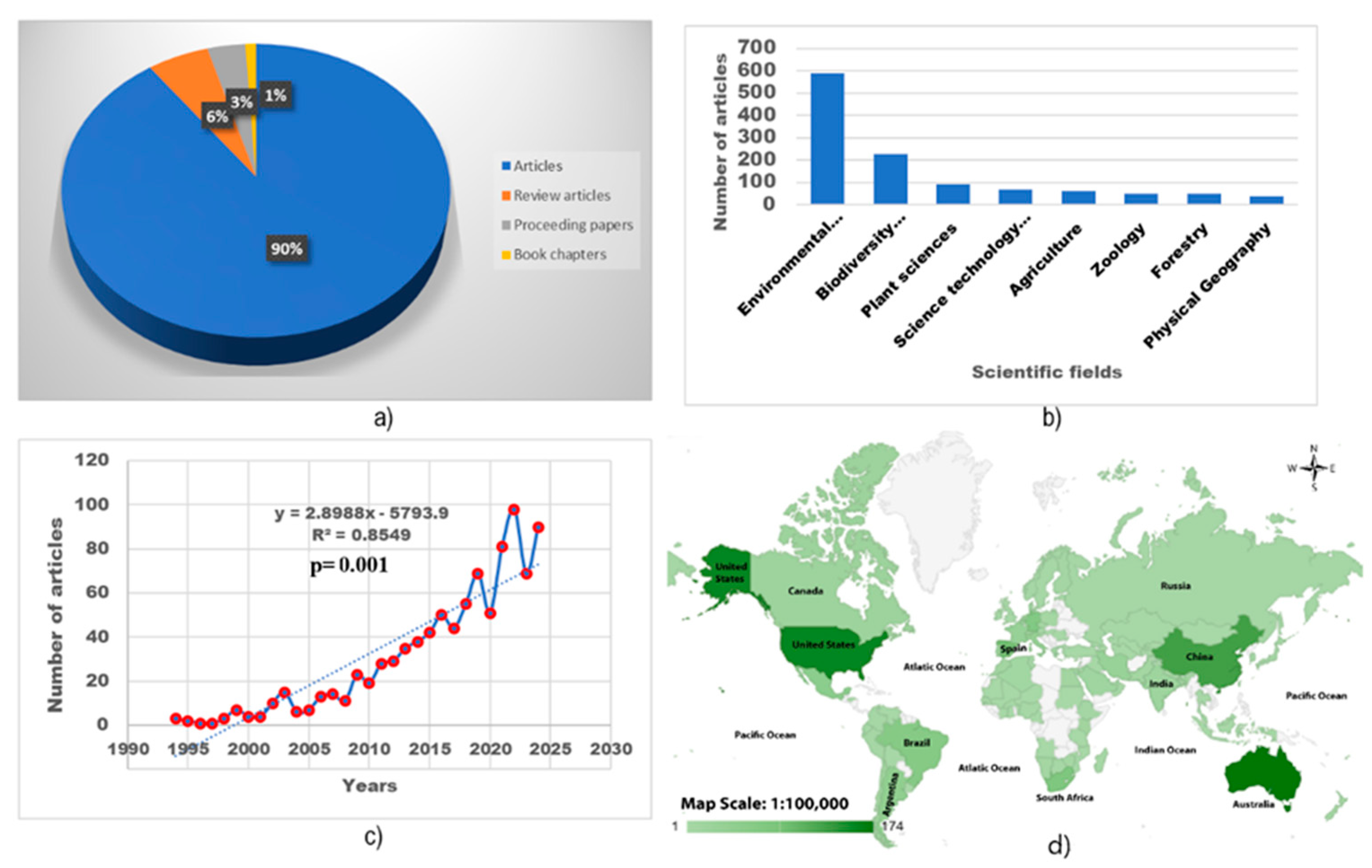
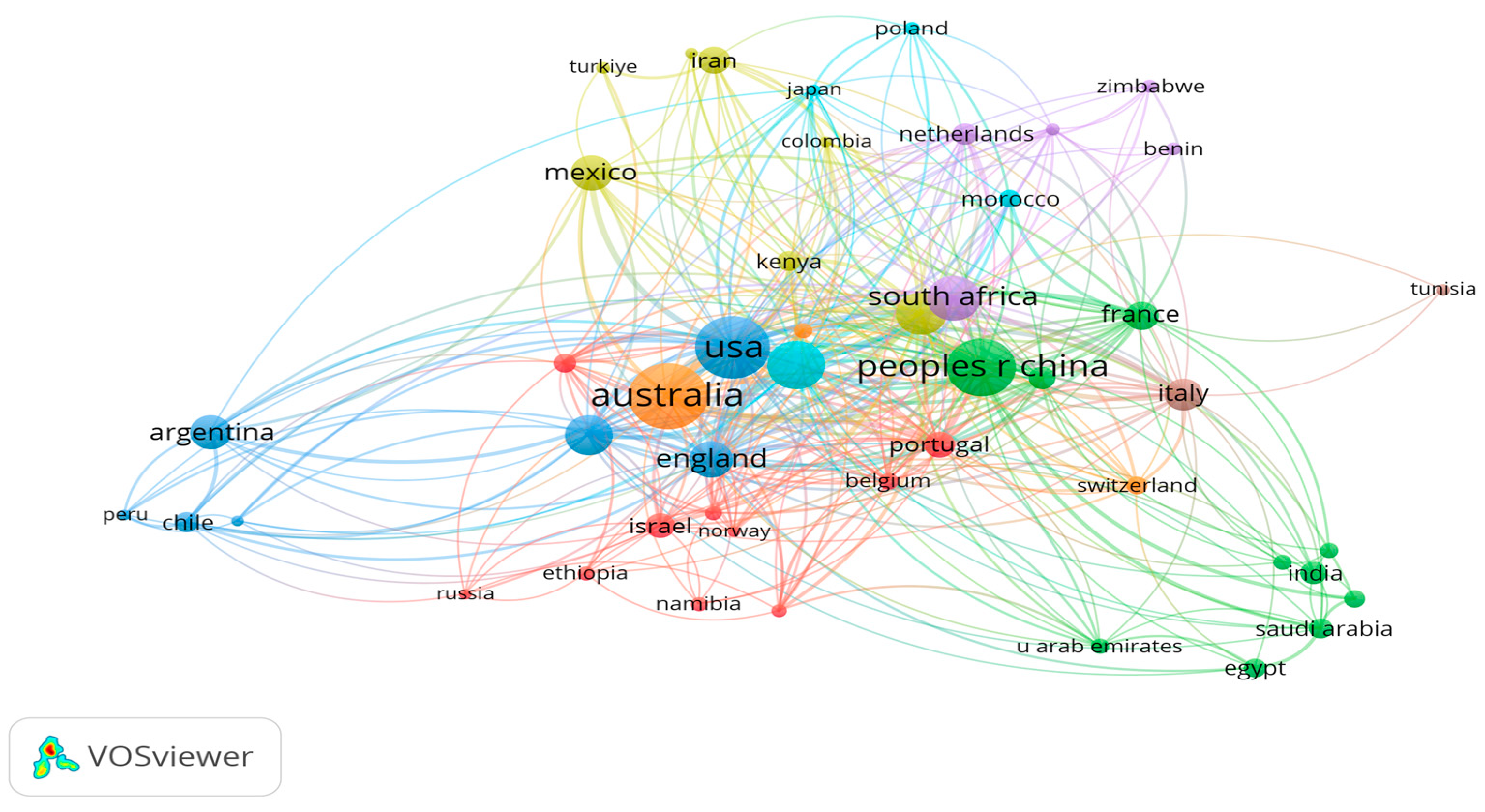
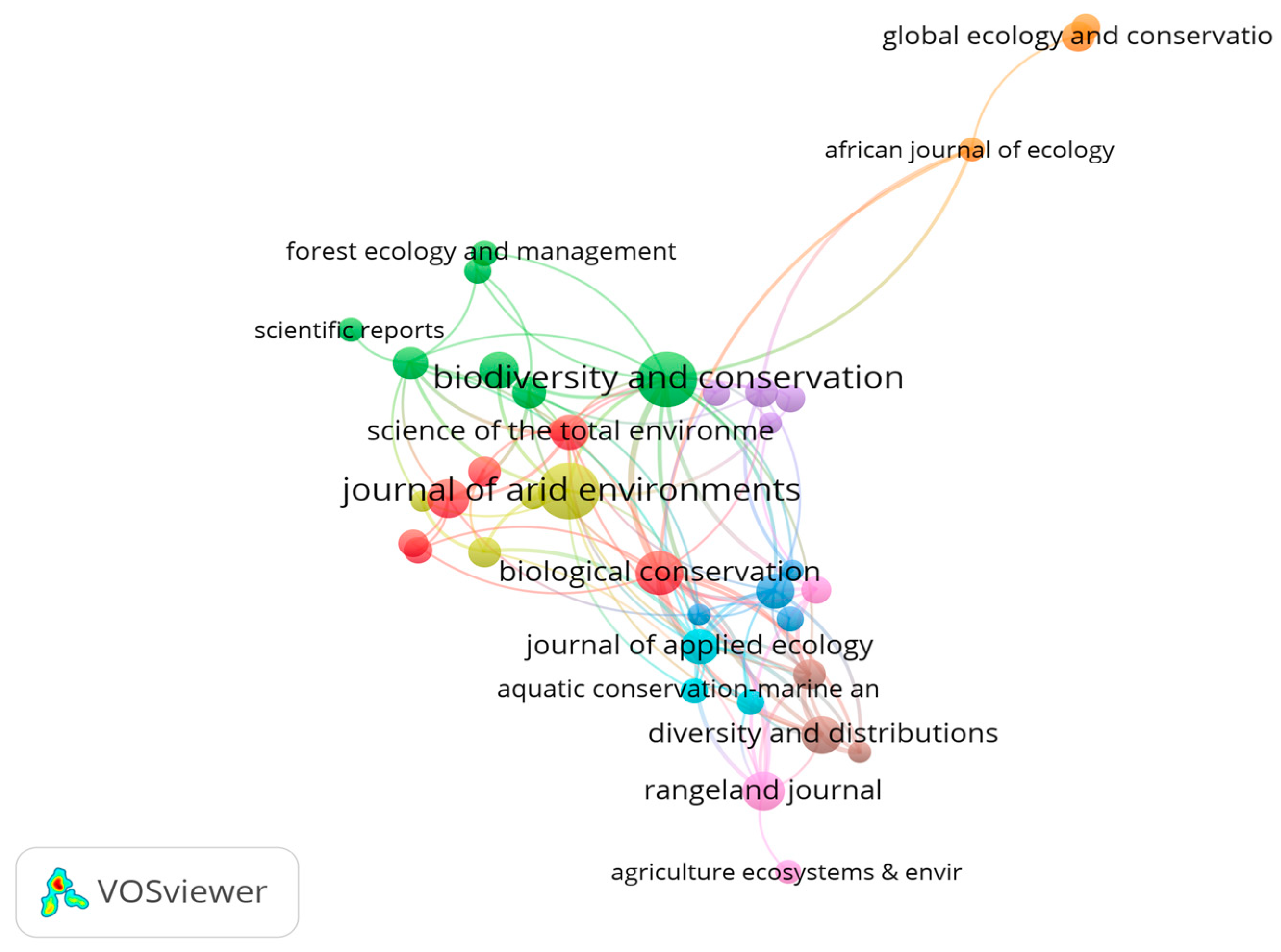

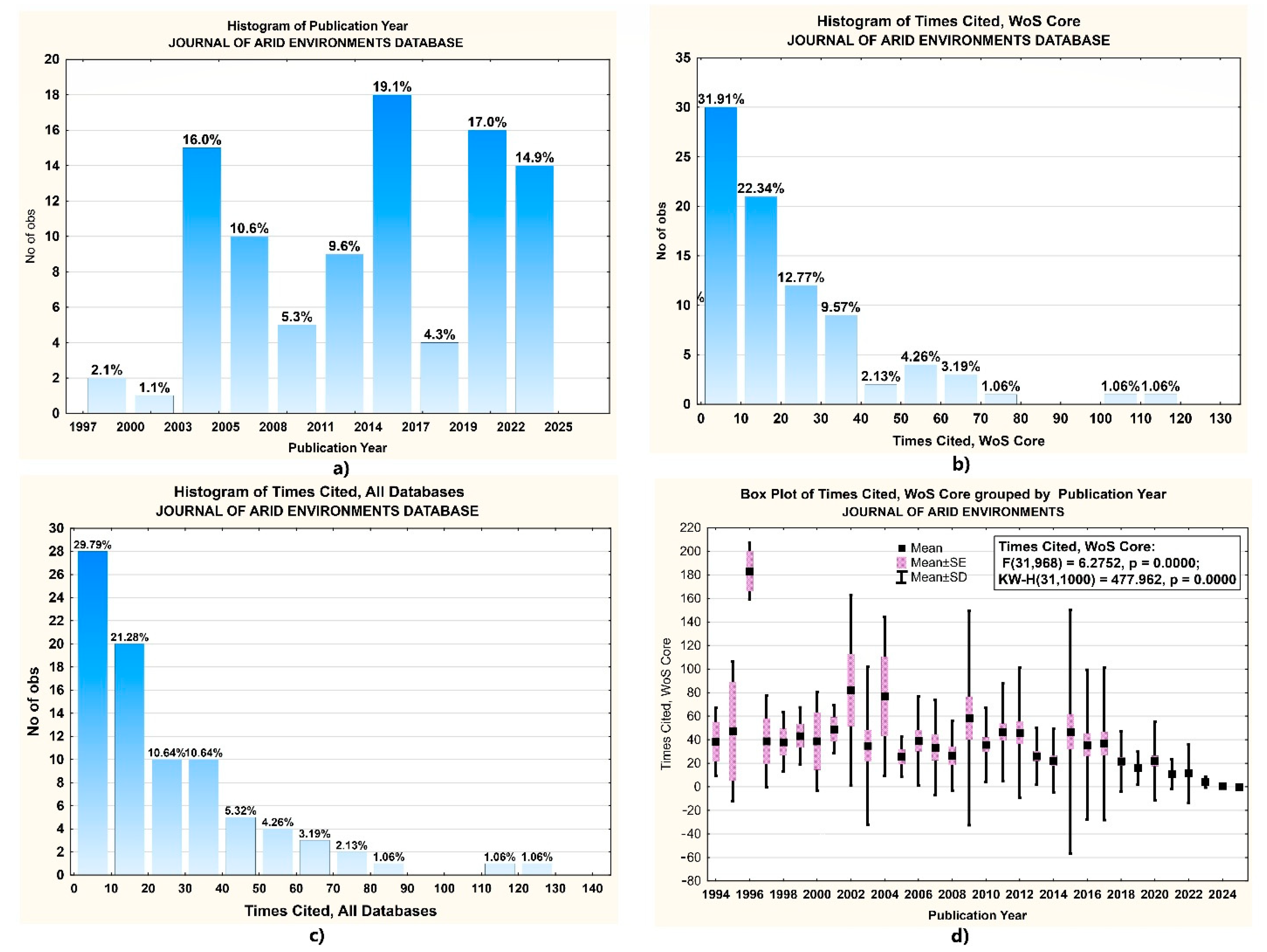
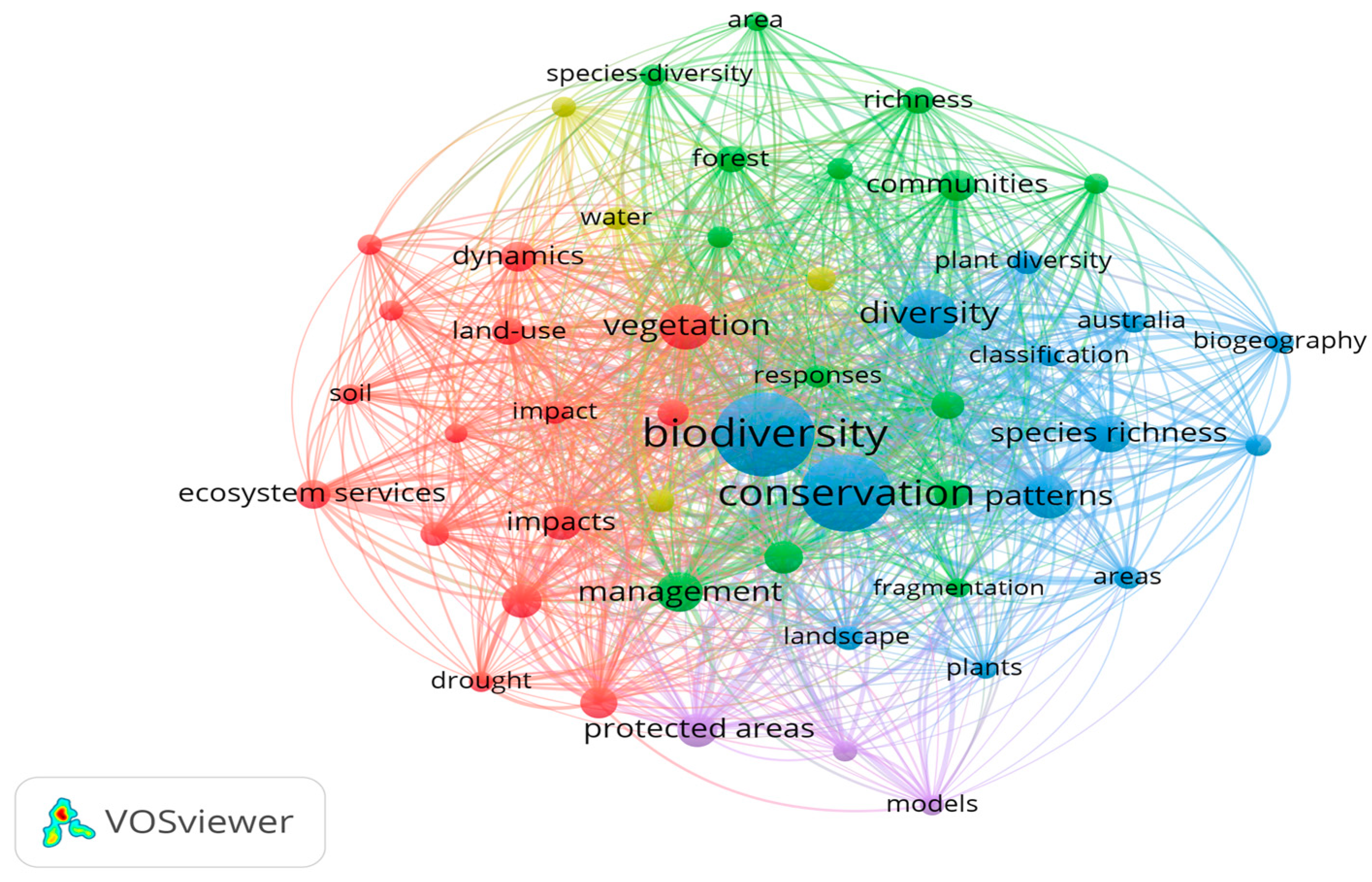
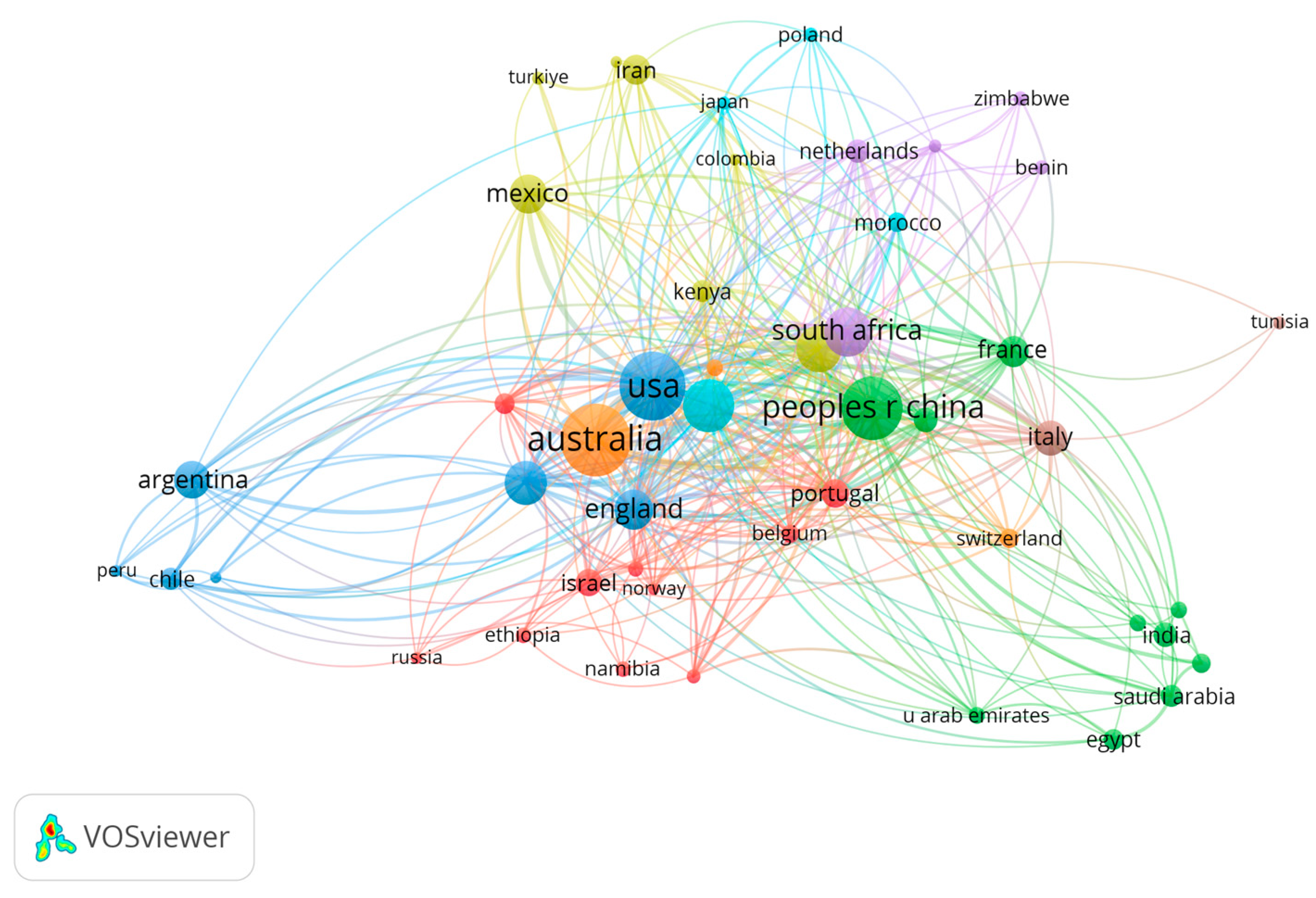
| Crt. No. | Journal | Documents | Citations | Total Link Strength |
|---|---|---|---|---|
| 1 | Biological Conservation | 24 | 1813 | 37 |
| 2 | Biodiversity and Conservation | 37 | 916 | 28 |
| 3 | Journal of Applied Ecology | 15 | 681 | 27 |
| 4 | Diversity and Distributions | 18 | 631 | 23 |
| 5 | Conservation Biology | 11 | 1213 | 21 |
| 6 | Journal of Arid Environments | 39 | 814 | 17 |
| 7 | Rangeland Journal | 19 | 300 | 15 |
| 8 | Plos One | 15 | 282 | 14 |
| 9 | Landscape and Urban Planning | 6 | 258 | 13 |
| 10 | Ecological Application | 10 | 1146 | 12 |
| 11 | Ecological Indicators | 19 | 441 | 12 |
| 12 | Land | 13 | 143 | 12 |
| 13 | Journal of Biogeography | 11 | 1016 | 11 |
| 14 | Science of the Total Environment | 15 | 312 | 11 |
| 15 | Diversity | 12 | 108 | 9 |
| Crt. No. | Keyword | Occurrences | Total Link Strength |
|---|---|---|---|
| 1 | biodiversity | 435 | 1290 |
| 2 | conservation | 356 | 1078 |
| 3 | diversity | 146 | 511 |
| 4 | vegetation | 131 | 446 |
| 5 | patterns | 113 | 385 |
| 6 | species richness | 85 | 346 |
| 7 | management | 99 | 338 |
| 8 | impacts | 69 | 235 |
| 9 | climate change | 72 | 219 |
| 10 | protected areas | 71 | 218 |
| 11 | communities | 61 | 201 |
| 12 | land use | 49 | 194 |
| 13 | habitat | 52 | 193 |
| 14 | biodiversity conservation | 66 | 182 |
| 15 | dynamics | 54 | 182 |
| 16 | ecology | 49 | 181 |
| Crt. No. | Species | Significance of Species | Geographical Area | Cited by |
|---|---|---|---|---|
| 1 | Acacia reficiens Wawra | invasive species | Kenya | David et al., 2020 [35] |
| 2 | Agave aurea Brandegee | endemic species | Baja California Peninsula, USA | Klimova et al., 2024 [36] |
| 3 | Alhagi sparsifolia Shap. | species adapted to drought | Worldwide | Tariq et al., 2022 [37] |
| 4 | Boswellia dalzielii Hutch. | keystone species | Burkina Faso | Sabo et al., 2023 [38] |
| 5 | Commiphora sp. | endemic species | Yemen, India | La Montagna et al., 2023, [39]; Kulloli et al., 2013, [40] |
| 6 | Faidherbia albida (Delile) A. Chev | keystone species | Ghana | Akpalu et al., 2022 [41] |
| 7 | Glycyrrhiza uralensis Fischer | endangered species | North China | Zhang et al., 2010 [42] |
| 8 | Hordeum vulgare L. | keystone species | Worldwide | Visioni et al., 2023 [43] |
| 9 | Linaria nigricans Lange | endangered species | Spain | Penas et al., 2011 [44] |
| 10 | Opuntia stricta Haw. | invasive species | Kenya | Muthoka et al., 2021 [45] |
| 11 | Phoenix pusilla Gaertn. | endemic species | India | Kinhal et al., 2010 [46] |
| 12 | Piliostigma thonningii (Schumach.) Milne-Redh. | indigenous species | Ethiopia | Hailemariam et al., 2021 [47] |
| 13 | Primula boveana Decne. ex Duby | one of the rarest and threatened plants worldwide | Egipt | Abdelaal et al., 2020 [48] |
| 14 | Prosipis cineraria (L.) Druce (Ghaf) | dominant species in hot subdesert areas worldwide | United Arab Emirates, Western Asia | Kalarikkal et al., 2022, [49]; Baibout et al., 2022, [50] |
| 15 | Prosopis juliflora (Swartz) DC. | invasive species | Southwestern Iran | Amiri et al., 2022 [51] |
| 16 | Quercus sp. | native species | Iran | Sadeghi et al., 2024 [52] |
| 17 | Rosa arabica Crép. | endemic species | Southern Sinai, Egypt | Omar and Elgamal, 2021 [53] |
| 18 | shrub species (Chuquiraga avellanedae, Schinus johnstonii and Larrea divaricata) | native plants | The Monte, Argentina | Martinez et al., 2021 [54] |
| 19 | Stipa tenacissima L. | the species playing an important ecological role in arid and semiarid ecosystems | Tunisia | Ben Mariem and Chaieb, 2017 [55] |
| 20 | Tamarix ramosissima Ledeb. | an invader species of arid and semi-arid environments | Argentina | Natale et al., 2010 [56] |
| 21 | Vachellia (Acacia) tortilis (Forskk.) and Vachellia stuhlmannii (Taub.) | ecologically and economically important plant species in the African savanna ecosystem | Africa | Nkosi, 2024 [57] |
| Crt. No. | Species/Group of Species | Significance of Species | Geographical Area | Cited by |
|---|---|---|---|---|
| Invertebrates | ||||
| 1 | ground-dwelling arthropods | keystone species | Gobi desert, China | Li et al., 2013 [58] |
| 2 | desert pallid bee (Centris pallida) | native species | arid landscapes Spanning the southwestern United States and northwestern Mexico | Cruz et al., 2024 [59] |
| 3 | darkling beetles | keystone species | Patagonia, Argentina | Cheli et al., 2021 [60] |
| 4 | Tenebrionidae | keystone species | China; Patagonia, Argentina; | Li et al., 2022 [61]; Cheli et al., 2013 [62] |
| 5 | Cephalota deserticoloides | endemic species | Southeast Iberian, Spain | Herrera-Russert et al., 2021 [63] |
| 6 | Anopheles sp. | keystone species | Caatinga, Brazil | Marteis et al., 2015 [64] |
| 7 | trapdoor spider | keystone species | Southern Australia | Rix et al., 2017 [65] |
| 8 | spiders | keystone species | Pacific Northwest, USA | Smith, DiCarlo and DeBano, 2021 [66] |
| 9 | scorpions | keystone species | Egypt | Lira et al., 2023 [67] |
| 10 | ants | keystone species | Sonoran Desert, Mexico; Karnataka, India | Bestelmeyer and Schooley, 1999 [68]; Begum et al., 2021 [69] |
| 11 | epigean insects | keystone species | Pingüino de Humboldt National Reserve in Chile | Pizarro-Araya et al., 2014 [70] |
| 12 | wild cockroaches Moluchia brevipennis | endemic species | Chile | Schapheer et al., 2017 [71] |
| 13 | Butterfly (general) | keystone species | Arizona, USA | Rowe et al., 2023 [72] |
| 14 | melitaeine butterflies, Euphydryas aurinia and Melitaea phoebe. | keystone species | Northern China | Wang et al., 2007 [73] |
| Vertebrates | ||||
| Fish | ||||
| 15 | fish (general) | keystone species | Mexico | Contreras-B et al., 2014 [74] |
| 16 | Nile tilapia, Oreochromis niloticus | invasive species | Southeastern Arabian Peninsula | Esmaeili et al., 2023 [75] |
| Amphibians | ||||
| 17 | amphibian (general) | keystone species | West Sahara-Sahel; Hidalgo, Mexico | Sampaio et al., 2021 [76]; Roth-Monzón et al., 2018 [77] |
| Reptiles | ||||
| 18 | reptiles (general) | keystone species | Souss-Massa National Park, Marocco; Oman | Elbahi et al., 2023 [78]; Carranza et al., 2018 [79] |
| 19 | gecko (Gehyra variegata) | native species | Australia | Duckett et al., 2013 [80] |
| 20 | Pristurus rupestris rupestris | keystone species | Arabia | Garcia-Porta et al., 2017 [81] |
| 21 | snail (general) | keystone species | Australia | Rossini et al., 2017 [82] |
| 22 | Moorish tortoise (Testudo graeca soussensis) | protected species | Marocco | Lagarde et al., 2012 [83] |
| Birds | ||||
| 23 | birds (general) | keystone species | Quitobaquito Springs, Arizona, USA; South Africa; northeastern Brazil | Flesch et al., 2023 [84]; Githaiga-Mwicigi et al., 2002 [85]; Alves et al., 2013 [86] |
| 24 | Otus scops | endangered species | Alicante, Spain | Martinez et al., 2007 [87] |
| 25 | Neotis nuba | endangered species | Niger | Crego et al., 2023 [88] |
| Mammals | ||||
| 26 | large mammals | keystone species | Central Asia | Berger et al., 2013 [89] |
| 27 | small mammals | keystone species | Australia, the dry Andes of northwestern Argentina | Pedler et al., 2016 [90]; Urquizo et al., 2022 [91] |
| 28 | Bats (general) | keystone species | World, the southern Judean plains of Israel | Lison et al., 2020 [92]; Kahnonitch et al., 2018 [93] |
| 29 | Rodent (general) | keystone species | Mexico | Acosta and Fernandez, 2015 [94] |
| 30 | pale field-rat (Rattus tunneyi) | native species | Edel Land, Shark Bay, Western Australia | O’Neill et al., 2021 [95] |
| 31 | Ludwig’s bustard Neotis ludwigii | endemic species | South Africa | Evans, 2023 [96] |
| 32 | Kangaroo | native species | Queensland, Australia | McAlpine et al., 1999 [97] |
| 33 | Dasyurus hallucatus | endangered species | Australia | Dunlop et al., 2017 [98] |
| 34 | fox (Vulpes vulpes) | keystone species | Australia, Sahara | Sheldon et al., 2023 [99]; Karssene, 2017 [100] |
| 35 | dingoe | native species | Australia | Tatler et al., 2019 [101] |
| 36 | Andean Cat (Leopardus jacobita) | endangered species | Central Andes of Chile | Zapararte et al., 2022 [102] |
Disclaimer/Publisher’s Note: The statements, opinions and data contained in all publications are solely those of the individual author(s) and contributor(s) and not of MDPI and/or the editor(s). MDPI and/or the editor(s) disclaim responsibility for any injury to people or property resulting from any ideas, methods, instructions or products referred to in the content. |
© 2025 by the authors. Licensee MDPI, Basel, Switzerland. This article is an open access article distributed under the terms and conditions of the Creative Commons Attribution (CC BY) license (https://creativecommons.org/licenses/by/4.0/).
Share and Cite
Timis-Gansac, V.; Dinca, L.; Constandache, C.; Murariu, G.; Cheregi, G.; Timofte, C.S.C. Conservation Biodiversity in Arid Areas: A Review. Sustainability 2025, 17, 2422. https://doi.org/10.3390/su17062422
Timis-Gansac V, Dinca L, Constandache C, Murariu G, Cheregi G, Timofte CSC. Conservation Biodiversity in Arid Areas: A Review. Sustainability. 2025; 17(6):2422. https://doi.org/10.3390/su17062422
Chicago/Turabian StyleTimis-Gansac, Voichita, Lucian Dinca, Cristinel Constandache, Gabriel Murariu, Gabriel Cheregi, and Claudia Simona Cleopatra Timofte. 2025. "Conservation Biodiversity in Arid Areas: A Review" Sustainability 17, no. 6: 2422. https://doi.org/10.3390/su17062422
APA StyleTimis-Gansac, V., Dinca, L., Constandache, C., Murariu, G., Cheregi, G., & Timofte, C. S. C. (2025). Conservation Biodiversity in Arid Areas: A Review. Sustainability, 17(6), 2422. https://doi.org/10.3390/su17062422









